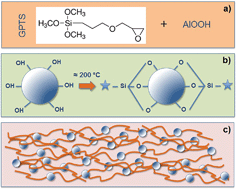Gravure printed sol–gel derived AlOOH hybrid nanocomposite thin films for printed electronics
Abstract
We report a sol–gel approach to fabricate aluminum oxyhydroxide (AlOOH)-based inks for the gravure printing of high-dielectric-constant nanocomposite films. By reacting 3-glycidoxypropyl-trimethoxysilane (GPTS) with aluminum oxyhydroxide (AlOOH) nanoparticles under constant bead milling, inks suitable for gravure printing were obtained. The calculated relative dielectric constants based on the measured capacitances and film thicknesses for the gravure-printed GPTS : AlOOH nanocomposites varied between 7 and 11 at a frequency of 10 kHz. The dielectric constant depended on the mixing ratio of the composite and was found to follow the Maxwell-Garnett ternary-system mixing rule, indicating the presence of micro/nanopores, which affect the electrical properties of the fabricated films. An increasing leakage current with increasing AlOOH content was observed. The high leakage current was reduced by printing two-layer films. The double-layered gravure-coated films exhibited a similar capacitance density, but a clearly lower leakage current and fewer electrical breakdowns compared to single-layered films with comparable film compositions and film thicknesses. The best composite yielded a capacitance density of 109 ± 2 pF mm−2 at 10 kHz frequency and a leakage current density of 60 ± 20 μA cm−2 at a 0.5 MV cm−1 electric field as a single layer. The calculated relative dielectric constant at 10 kHz frequency for this composition was 11.2 ± 0.5.


 Please wait while we load your content...
Please wait while we load your content...